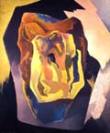crossing the line

Still Life XIV with Chair, ca. 1940
William Schwartz
oil on canvas
Illinois State Museum Collection
Click image for larger view.
William S. Schwartz is an artist who consciously and conscientiously explored varying degrees of abstraction. Much of his work had a firm grounding in the material world, as in Still Life XIV (right). Objects are recognizable. Space is understandable. In short, there is a limited degree of abstraction.
In his Symphonic Forms series, the artist abandoned most recognizable imagery, turning his attention to music in order to give visual form to something that is essentially non-visual.
Schwartz and other artists who were working abstractly struggled to forge visual clues that would provide personal insight into their most intimate experiences and sensations. They hoped the vocabulary on images they were inventing would be understood by viewers of their artwork.

Variations on an Idaho, Theme: Symphonic Forms #34
oil on canvas
30 by 40 inches
Illinois State Museum Collection
Click image for larger view.
Arriving in Chicago in 1912 William Samuel Schwartz quickly made a name for himself at the School of the Art Institute and went on to become one of the most prolific artists of his generation working successfully in painting (oil and watercolor), printmaking, and sculpture. Still Life XIV is typical of his realist approach that was heavily influenced by modernist ideas about space and form.
Objects are rendered in believable three dimensions, yet they donít quite sit flat. Schwartz’s palette is instantly recognizable and tends toward “acid” tinged and jarring combinations of color next to one another. His turbulent personal life was often played out in his paintings and in this work we see not only a still life of domestic objects but a thinly-veiled erotic fantasy.
An accomplished singer, Schwartz supported himself during his youth by singing in operas and presenting concerts. During this period he developed an enduring interest in the abstract nature of music. He moved easily between abstraction and realism in his painting and it seemed logical that, like many artists, he would seek to fuse the abstract qualities of music with visual expression.
Sometime during the 1930s he embarked on a numbered series of highly abstract paintings entitled Symphonic Forms. Often these works had their origin in the real world and were realized in the same shifting planes and acrid color that was present in his more realist work.